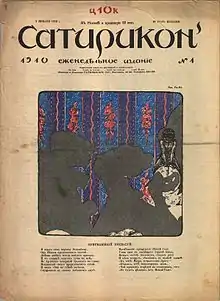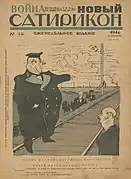Novyi Satirikon
Novyi Satirikon was a Russian language weekly humor and satirical magazine that was published in Saint Petersburg in the period 1908–1914. During the 1917 Revolution, the magazine held an anti-Bolshevik political stance, and most of its contributors had to flee Russia after the magazine was closed in 1918.
 Cover page dated January 1910 | |
| Categories | Satirical magazine |
|---|---|
| Frequency | Weekly |
| Founded | 1908 |
| Final issue | August 1918 |
| Country | |
| Based in | Saint Petersburg |
| Language | Russian |
History and profile
The magazine was started with the title Satirikon in 1908.[1] It was published on a weekly basis.[2] Due to financial problems between the publisher and the editors some editors left the magazine and started a new magazine in 1913 which was named Novyi Satirikon (New Satirikon).[3][2] Other editors continued Satirikon until spring 1914 when it folded.[3]
Novyi Satirikon targeted the liberal democratic intelligentsia and were read by high school and university students, deputies in the State Duma, ministers and senators in the State Council.[3] During World War I Novyi Satirikon of which editor-in-chief was Arkady Averchenko published nationalist and patriotic materials[3] and adopted an anti-German political stance.[4] The magazine welcomed the February Revolution as "freedom" and published cartoons on the Tsar Nicholas II.
From 1913 Vladimir Lebedev began to work as a caricaturist for the magazine.[2] Writers Teffi, Vladimir Mayakovsky and Sasha Chorny were among the major contributors of the magazine.[1][5] At the beginning of the Communist revolution in 1917 the magazine advocated a radical anti-Bolshevik approach which became much more intense following the Bolshevik rule.[6] The satire adopted by Novyi Satirikon was extensively ironic and sarcastic during that period.[6]
Novyi Satirikon survived the press decree issued by the Communist government led by Vladimir Lenin and was published until August 1918 (issue 24) when it was censored and then, shut down by the government because of its anti-Bolshevik views.[3][6]
Legacy
Exiled contributors of the magazine revived the satirical magazine in Paris in 1931. In 1951, a group of Soviet dissidents started a new satirical magazine also named Satirikon in Frankfurt-am-Main.[3] Another magazine with the same name was also launched in Moscow in 1997.[3] All these publications existed for a short period.[3]
Gallery
 Cover from 1916
Cover from 1916 A cartoon on Nicholas II (1917) by Dmitry Moor
A cartoon on Nicholas II (1917) by Dmitry Moor Cover from 1918
Cover from 1918 Cover from 1918 with a cartoon on Leon Trotsky
Cover from 1918 with a cartoon on Leon Trotsky
See also
References
- Oleg Minin (2014). "Russian Artists in the United States. The Case of Nicholas Remisoff (1887-1975)". Experiment. 20 (1): 230–232. doi:10.1163/2211730X-12341264.
- Nicoletta Misler (Summer 1987). "A Public Art: Caricatures and Posters of Vladimir Lebedev". The Journal of Decorative and Propaganda Arts. 5: 62. doi:10.2307/1503936. JSTOR 1503936.
- Lesley Milne (October 2006). "Novyi Satirikon, I9I4-I9I8: The Patriotic Laughter of the Russian Liberal Intelligentsia during the First World War and the Revolution". The Slavonic and East European Review. 84 (4). JSTOR 4214359.
- A.B. Astashov (2018). "Violation of the Laws and Customs of War on the Russian Front in the First World War". Russian Studies in History. 57 (1): 22. doi:10.1080/10611983.2018.1577095. S2CID 165059157.
- Edythe C. Haber (2007). "The Roots of NEP Satire: The Case of Teffi and Zoshchenko". The NEP Era: Soviet Russia 1921-1928. 1. hdl:11299/186866.
- Annie Gérin (2018). Devastation and Laughter. Satire, Power, and Culture in the Early Soviet State, 1920s–1930s. Toronto; Buffalo; London: University of Toronto Press. p. 45. doi:10.3138/9781487515324-007. ISBN 978-1-4875-0243-0. S2CID 239341837.
External links
 Media related to Satirikon (magazine) at Wikimedia Commons
Media related to Satirikon (magazine) at Wikimedia Commons